Literacy and Education
Inventory of Thomas Hyndmers of Bearle, Bywell St Andrew
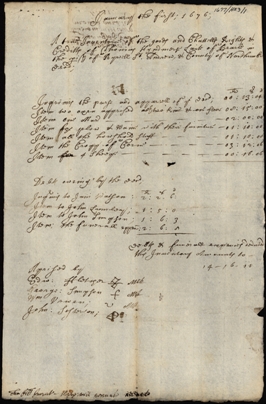
Those who could not write could place a 'mark' beside their name on a document. Hyndmers' inventory points to his farming activity, and here the appraisors appear to have used personal symbols to sign the document that, it is tempting to imagine, were their personal stock brands or trade marks: blacksmiths sometimes used horseshoe marks. Normally a testator would dictate the testament to a clerk, often the local vicar, and the document having been cleanly written out and read aloud to the testator would then be assented to, signed and perhaps sealed, witnessed and so published.
Ref: DPRI/1/1677/H23/1.
![]()
Will of Henry Clements of North Shields, royal navy mariner
Will of Peter Trumbel of Gateshead, butcher
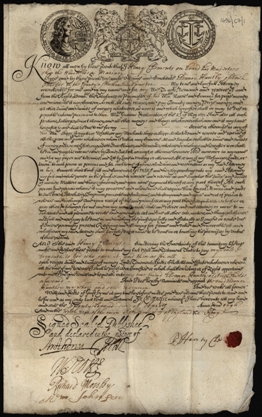
One solution to the potentially knotty problems of probate and widespread illiteracy was to issue pro forma printed wills. Clements served on H.M.S. Winchelsea, making his will in April 1696 probably when he joined the ship as a part of the process of signing on. A more business-oriented appropriation of print technology is evident in Peter Trumbel's unusual print block, which he probably used in connection with his butchery trade, perhaps to stamp carcases or bills. The fact that this stamp was a valid equivalent of a signature or seal illustrates a different attitude then prevalent toward this medium.
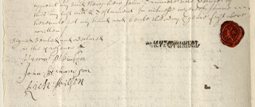
Ref: DPRI/1/1696/C7/1-2; DPRI/1/1689/T7/1-2.
Inventory of Robert Fowberie M.A., master of Newcastle Royal Free Grammar School
Will of Amor Oxley, vicar of Kirknewton and master of Newcastle Royal Free Grammar School
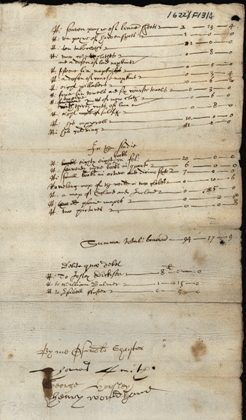
Robert Fowberie, who taught both Latin and Greek, was the first master appointed to Newcastle's grammar school after it was re-founded by royal charter in 1599, the original grammar school having been endowed by the city mayor Thomas Horsley some seventy years earlier. Many of Fowberie's pupils would have been the sons of Newcastle merchants whose trading interests might have been traced across the 'large map of the world in 2 globes'. Oxley's will includes the bequest of a number of theological and classical works 'towards a library' for the school where he taught. Oxley had been removed from his post in 1645 for his attachment to the king's cause, but secured his reappointment after the restoration having suffered great poverty in the interim. Both Newcastle and Durham grammar schools are today independent schools.
Refs: DPRI/1/1622/F13/3-4; DPRI/1/1669/O5/1-2.
List of books on loan, attached to the will of John Pilkington of Durham
Inventory of Luce Addison of Berwick-upon-Tweed, widow
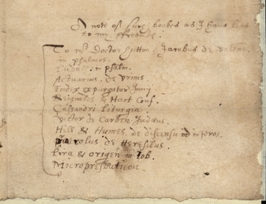
Many persons would have possessed a small number of writings in the form of property deeds, bonds, a bible and perhaps a last will and testament, but the ownership of literary texts and practical manuals was usually limited to churchmen and professionals. Owners would circulate books among trusted friends, particularly as this was then the only means of transmitting faithfully the work and ideas of the author. Pilkington's library had been inherited from his father, an archdeacon of Durham, and many senior officials of the bishopric are named among the borrowers. Such detailed catalogues of books can provide historians with an index of the intellectual tastes and political attitudes of a society, and in some cases particular copies have been found to survive in Special Collections like that at Durham University. In contrast, Lucy Addison carefully annexes to her will a schedule of all her legal writings, her debts being a little less securely recorded 'as appears by chalkes upon a borde'.
Refs: DPRI/1/1609/P3/1-4; DPRI/1/1611/A1/3.
Account of the execution of the will of Robert Phillipps of Gateshead, cordwainer, and of the tuition of his son Thomas Phillipps
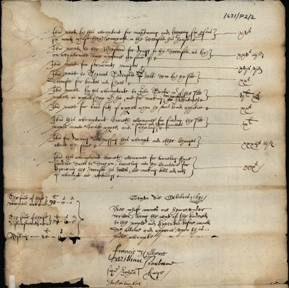
Phillipps' son was too young to act as executor, and his tutor Thomas Arrowsmyth here accounts for disbursments out of his father's estate during the boy's minority, and which include the price of his apprenticeship to his new master John Tailor, a new pair of boots and shoes and two suits of clothes. The account also reveals that prior to this Thomas Phillipps had spent 1 ¾ years at school. Apprentices typically bound themselves to a master of a trade for seven years. They received no wages, but did receive board and lodging: at the end of this period the freed apprentice would begin his independent career as a skilled journeyman with a valuable and secure place in his trade and often with some education as well. There are over 200,000 apprentices working today in the United Kingdom,and while they now earn a wage they might still serve up to five years before qualification.
Ref: DPRI/1/1631/P2/1-2.


